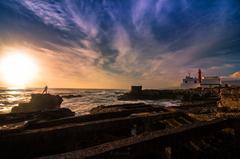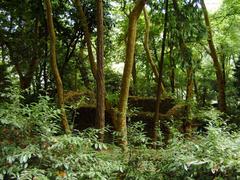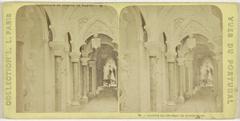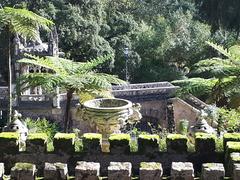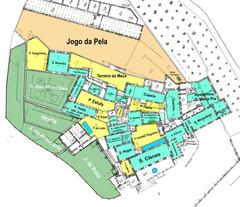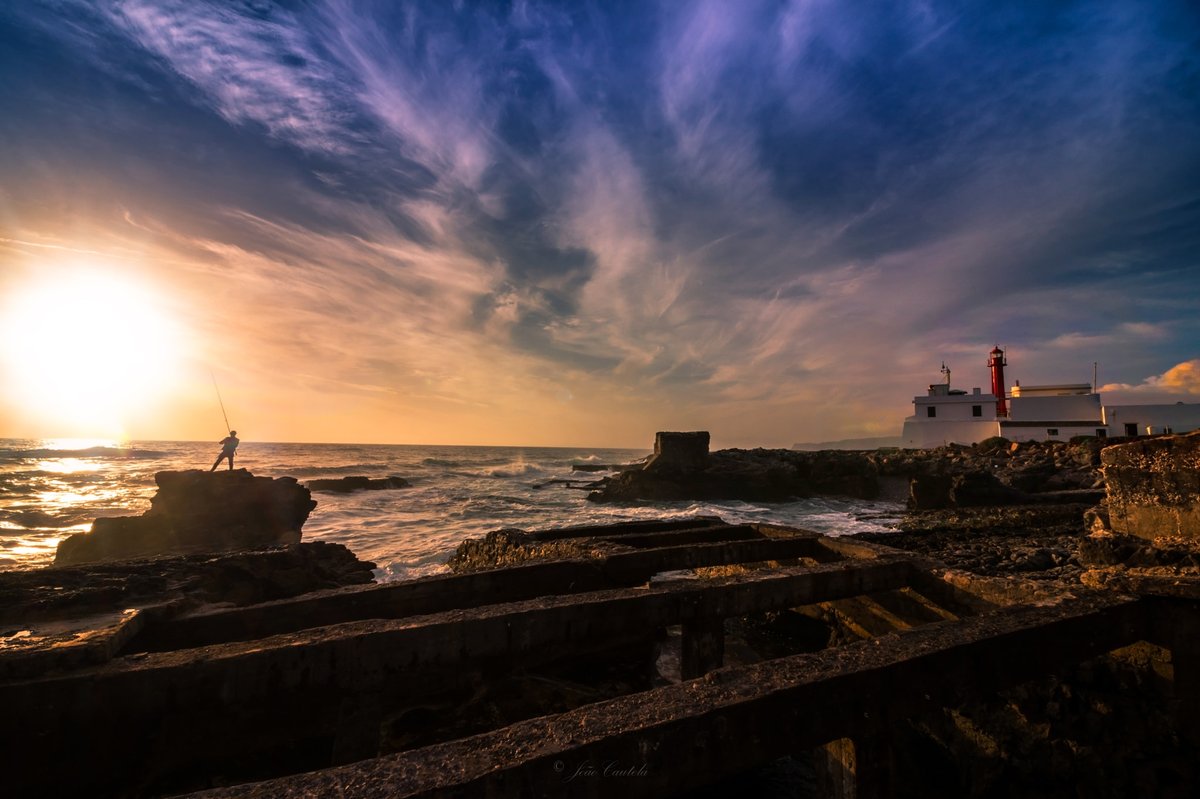
Visiting Hours and Tickets for Farol do Cabo Raso in Sintra
Date: 23/07/2024
Introduction
Farol do Cabo Raso, located in the scenic town of Sintra, Portugal, is a lighthouse of notable historical, architectural, and cultural importance. First lit on February 1, 1915, this iconic structure has played a pivotal role in maritime navigation along Portugal’s rugged Atlantic coastline. Built as part of a broader initiative to enhance coastal safety, the lighthouse was initially equipped with a fourth-order Fresnel lens, a cutting-edge technology of its time (Visit Portugal). Over the years, it has undergone several upgrades, including automation and the replacement of the original oil lamp with an electric light, ensuring its continued effectiveness in guiding vessels through treacherous waters. The lighthouse’s blend of functionality and aesthetic appeal, marked by its striking red and white color scheme, has made it a subject of interest for both historians and architects (Sintra Private Tours). Beyond its practical role, Farol do Cabo Raso stands as a symbol of Portugal’s rich maritime heritage and resilience, having witnessed significant historical events such as the World Wars and the Carnation Revolution. Today, it remains a vital part of Portugal’s coastal infrastructure and a popular destination for visitors interested in history, architecture, and natural beauty. This comprehensive guide explores the lighthouse’s history, significance, and practical visitor information to help you plan an enriching visit to Farol do Cabo Raso.
Table of Contents
- Introduction
- Historical Background
- Architectural Significance
- Maritime Significance
- Cultural and Historical Impact
- Technological Advancements
- Visitor Experience
- Preservation Efforts
- Conclusion
- FAQ
Historical Background
Farol do Cabo Raso, located in Sintra, Portugal, has a rich history dating back to the early 20th century. The lighthouse was first lit on February 1, 1915, and has since played a crucial role in maritime navigation along the rugged Atlantic coast. The construction of the lighthouse was part of a broader initiative by the Portuguese government to enhance coastal safety and support maritime activities, which were vital for the country’s economy and defense.
The lighthouse was initially equipped with a fourth-order Fresnel lens, a state-of-the-art technology at the time. This lens allowed the light to be visible from a considerable distance, thereby aiding ships in navigating the treacherous waters around Cabo Raso. Over the years, the lighthouse has undergone several upgrades and renovations to keep up with technological advancements and to ensure its continued effectiveness.
Architectural Significance
Farol do Cabo Raso is not just a functional structure but also an architectural landmark. The lighthouse stands at a height of 13 meters (approximately 43 feet) and is constructed from robust materials designed to withstand the harsh coastal weather conditions. The design of the lighthouse is a testament to early 20th-century engineering and architectural practices, combining functionality with aesthetic appeal.
The lighthouse’s red and white color scheme is not only visually striking but also serves a practical purpose. The colors make the lighthouse easily identifiable during the day, complementing its powerful light that guides ships at night. The structure’s simplicity and elegance have made it a subject of interest for both historians and architects.
Maritime Significance
The primary function of Farol do Cabo Raso has always been to ensure the safety of maritime navigation. The lighthouse is strategically located at Cabo Raso, a point known for its rocky coastline and strong currents. These natural features pose significant risks to ships, making the lighthouse an essential navigational aid.
Over the years, Farol do Cabo Raso has prevented countless maritime accidents by providing a reliable point of reference for ships navigating the Atlantic Ocean. The lighthouse’s light, which has a range of 20 nautical miles, is a critical component of the coastal navigation system. It works in conjunction with other lighthouses along the Portuguese coast to create a network that ensures safe passage for vessels.
Cultural and Historical Impact
Farol do Cabo Raso is more than just a navigational aid; it is a cultural and historical icon. The lighthouse has been a silent witness to significant events in Portuguese history, including both World Wars and the Carnation Revolution of 1974. During these tumultuous times, the lighthouse continued to operate, symbolizing resilience and continuity.
The lighthouse is also part of the local community’s heritage. It has been featured in numerous works of art, literature, and photography, capturing the imagination of artists and writers. The lighthouse’s enduring presence has made it a symbol of stability and safety, deeply ingrained in the cultural fabric of the region.
Technological Advancements
Farol do Cabo Raso has seen several technological advancements since its inception. The original oil lamp was replaced with an electric light in the mid-20th century, significantly improving its brightness and reliability. In recent years, the lighthouse has been automated, reducing the need for a full-time lighthouse keeper.
The automation of the lighthouse involved the installation of modern sensors and control systems that ensure the light operates efficiently and effectively. These upgrades have extended the lighthouse’s operational life and enhanced its ability to serve the maritime community. Despite these changes, the lighthouse has retained its historical charm and continues to be a vital part of Portugal’s coastal infrastructure.
Visitor Experience
Farol do Cabo Raso is open to visitors who are drawn to its historical significance, architectural beauty, and stunning coastal views. Below is practical information to help you plan your visit:
- Visiting Hours: The lighthouse is open to visitors from 10 AM to 6 PM daily. However, it is advisable to check the official website for any changes in schedule.
- Tickets: Entry to the lighthouse is free, but guided tours are available at a nominal fee. Booking in advance is recommended.
- Accessibility: The lighthouse is accessible by car and offers parking facilities. While the lighthouse itself may have some accessibility limitations, the surrounding area is suitable for all visitors.
- Nearby Attractions: The nearby town of Sintra offers a wealth of attractions, including the Pena Palace, Quinta da Regaleira, and the Sintra National Palace. Combining a visit to these sites with the lighthouse makes for a fulfilling day trip.
- Travel Tips: Wear comfortable shoes for exploring the rocky coastline and bring a camera to capture the breathtaking views. Check the weather forecast before your visit and dress accordingly.
Preservation Efforts
Preserving Farol do Cabo Raso is a priority for both local authorities and heritage organizations. Efforts are ongoing to maintain the lighthouse’s structural integrity and historical authenticity. These initiatives include regular maintenance, restoration projects, and the use of modern preservation techniques.
The lighthouse is also part of educational programs aimed at raising awareness about maritime history and coastal conservation. Schools and universities often organize field trips to the lighthouse, providing students with a hands-on learning experience. These educational efforts ensure that future generations will continue to appreciate and protect this important historical landmark.
Conclusion
In conclusion, Farol do Cabo Raso is a lighthouse of great historical, architectural, and cultural significance. Its enduring presence on the Portuguese coast serves as a beacon of safety and a symbol of the region’s rich maritime heritage. Visitors to the lighthouse can enjoy a unique blend of history, natural beauty, and technological innovation, making it a must-see destination in Sintra, Portugal.
FAQ
- What are the visiting hours for Farol do Cabo Raso? The lighthouse is open to visitors from 10 AM to 6 PM daily.
- How do I get tickets for Farol do Cabo Raso? Entry is free, but guided tours are available for a nominal fee. Booking in advance is recommended.
- Is Farol do Cabo Raso accessible? The lighthouse is accessible by car with parking facilities available. Some areas may have accessibility limitations.
- What nearby attractions can I visit? Nearby attractions include the Pena Palace, Quinta da Regaleira, and the Sintra National Palace.
References
- Visiting Farol do Cabo Raso - History, Significance, and Visitor Information in Sintra, 2023, Unknown Author Visit Portugal
- Exploring Farol do Cabo Raso - Visiting Hours, Tickets, and Attractions in Sintra, Portugal, 2023, Unknown Author Sintra Private Tours
- Visitor Tips for Farol do Cabo Raso, Sintra - Best Time, Tickets, and Nearby Attractions, 2023, Unknown Author Parques de Sintra
